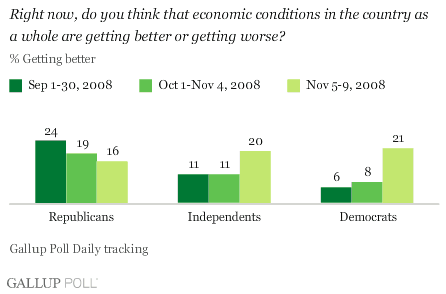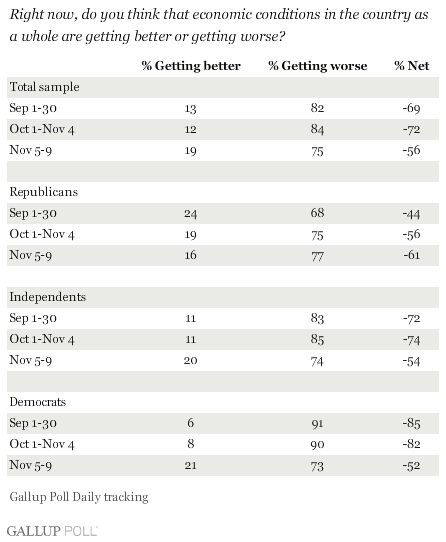PRINCETON, NJ -- The election of Barack Obama as the next U.S. president has been accompanied by a significant increase in optimism about the economy among Democrats and independents, even while Republicans have become somewhat more negative.

Gallup Poll Daily tracking of Americans' economic outlook clearly demonstrates how economic perceptions are bound up with politics. Republicans had been much more positive about the direction of the economy than were either independents or Democrats in September, and, to a slightly lesser degree, from October through Election Day, Nov. 4. This relative difference in optimism reflects a normal pattern by which those who identify with the party in the White House are generally more positive than those who are "on the outs."
But views on the direction of the economy shifted virtually overnight in the days after the election.

Republicans' views didn't change a lot, shifting slightly more toward the negative. But independents and Democrats' views shifted significantly in a positive direction. Independents' net optimism (the percentage saying the economy is "getting better" minus the percentage saying it is "getting worse") improved from -74 for Oct. 1 through Nov. 4 to -54 in the five days after the election (Nov. 5-9), while Democrats' net optimism improved even more dramatically, from -82 prior to the election to -52 in the days afterward.
These changes are, of course, relative. A majority of independents and Democrats did not suddenly become convinced that the economy was getting better. But the percentage "getting better" among Democrats jumped from 6% and 8% in September and October, respectively, to 21% in the days after the election, while the percentage saying the economy was getting worse dropped from 91% and 90%, respectively, to 73%. Independents saw a similar, though less dramatic, change.
Looked at differently, while Republicans were more positive about the economy than were independents and Democrats during September and from Oct. 1 through the election, in the days after the election, the last two groups have suddenly become the more optimistic.
(Of interest is that there has been little significant change in the three partisan groups' perceptions of current economic conditions -- as opposed to changes in perceptions of the direction of the economy, as discussed above. The election of Obama, in other words, has had much less effect on views of where the economy stands today.)
Implications
The uptick in positive views on the direction of the economy among independents and Democrats has moved average consumer confidence in this country to a somewhat more positive level since the Nov. 4 election. Net optimism across the American population was -69 in September and -72 from Oct. 1 to Nov. 4, but is now down to a somewhat less negative -56.
This finding underscores the degree to which consumer confidence can depend on intangibles rather than on consumers' hard-nosed assessments of real economic data. Obama's election and the pending arrival of a Democrat in the White House have already caused a mild shift toward the positive in consumer confidence.
There are two things to watch going forward. One, will this uptick in consumer confidence be short-lived, or can Obama sustain the more positive outlook as he makes appointments and outlines his economic plans between now and Jan. 20? Second, will this increase in consumer confidence translate into actual behavior and will consumers begin to spend more, particularly in the all-important Christmas shopping season? Gallup will be monitoring and reporting on these questions over the next few weeks and months.
Survey Methods
Results are based on telephone interviews with national adults, aged 18 and older, conducted as part of Gallup Poll Daily tracking, including 15,342 interviews conducted in September 2008; 17,585 interviews conducted between Oct. 1 and Nov. 4, 2008; and 2,530 interviews conducted Nov. 5-9, 2008. For results based on the sample of national adults interviewed in September and from Oct. 1-Nov. 4, one can say with 95% confidence that the maximum margin of sampling error is ±1 percentage point. For results based on the sample of national adults interviewed Nov. 5-9, the maximum margin of sampling error is ±2 percentage points.
Interviews are conducted with respondents on land-line telephones (for respondents with a land-line telephone) and cellular phones (for respondents who are cell-phone only).
In addition to sampling error, question wording and practical difficulties in conducting surveys can introduce error or bias into the findings of public opinion polls.
